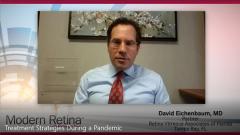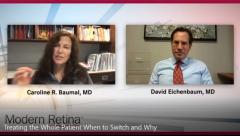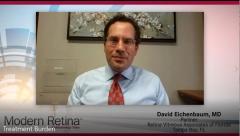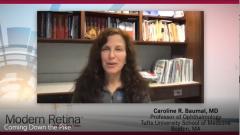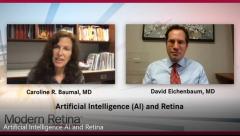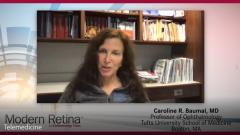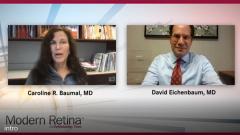
Improved Durability
Episodes in this series

Caroline R. Baumal, MD: What's the key to having more durability? Do you think it’s to have more VEGF inhibition? Should we do a combination therapy? Should we do a whole other type of technology? What do you think?
David Eichenbaum, MD: It's a great question. I think it's literally the billion-dollar question. I would hang my hat on intravitreal biologic monotherapy. I would hang my hat on molarity, getting a lot of juice in there. If you get a lot of juice in the eye with a relatively simple single tool that we use — more juice will get you more efficacy. However, it didn’t work in HARBOR with high-dose ranibizumab, which is interesting.
We'll see if it works with high-dose Eylea with your studies that are starting. It seems to have worked in HAWK and HARRIER to some extent, especially during the head-to-head with aflibercept versus brolucizumab.
Something better than anti-angiogenic monotherapy is probably the better answer. Perhaps finding inhibition of a second mechanism of action, perhaps a device that helps you deliver a lot more drug over a lot longer time, perhaps the gene therapy that turns your eye into an anti-VEGF factory or anti-whatever-second-target-that-is-determined-to-work factory.
There’s better stuff than using the same Phillips screwdriver we basically used in different sizes since 2005 with bevacizumab, but since that's all we've got commercially right now, I would say to me I would bet on the molarity being the difference maker. What one thing would you bet on as the difference maker in the current commercial landscape?
Dr. Baumal: In the current landscape I think that probably an agent that affects two different pathways might increase our durability overall, but I would go for something that prevents exudation. Overall, I think choroidal neovascularization is not necessarily a harmful thing. We see it develop in other diseases like in central serous retinopathy and in other entities almost as a response to ischemia or destruction of the retina, but if it's non-exudative, then choroidal neovascularization doesn’t typically cause any harm.
But when it starts to exude and affects the photoreceptors, that's when the problem starts. Something that really prevents the exudation — and that's why actually anti-VEGFs have been so successful. They prevent the exudation, and they treat that factor, so I think a drug that affects more than one pathway will be successful.
Dr. Eichenbaum: I want to see something that works on a second pathway, stabilizes the vasculature, reduces exudation, vis-a-vis reducing fibrosis, perhaps reducing the junk under the retina that may cause atrophy.
That second hit is what we're looking for. We struck gold with the anti-VEGF, so striking gold again is taking a lot of work. We've seen some failures in the last decade, but there are trials ongoing now with anti-angiopoietin that may have dual efficiency, and we'll see what we get. I’m very hopeful for that for same reason that you are, and I'm waiting with bated breath to see what happens.
Newsletter
Keep your retina practice on the forefront—subscribe for expert analysis and emerging trends in retinal disease management.


